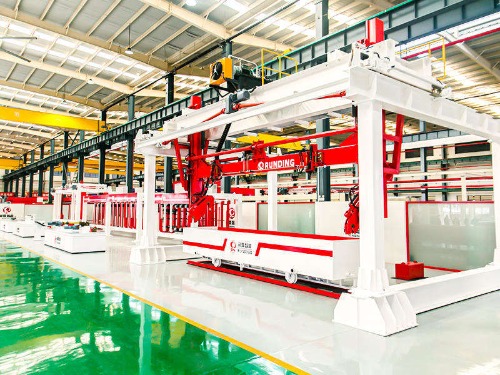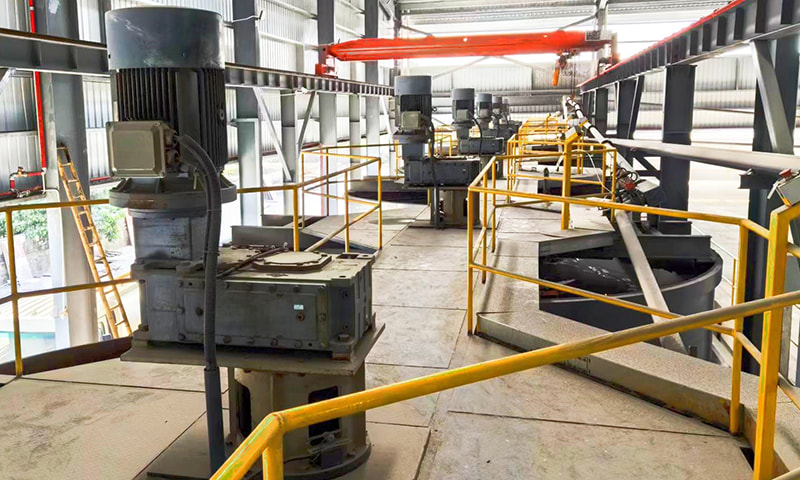Application of intelligent welding technology in AAC equipment manufacturing
The welding process in the traditional AAC machine manufacturing faces many challenges such as low efficiency, large deformation, and unstable quality. With the introduction of intelligent welding technology, these problems are being overcome one by one. The laser vision tracking welding system used in the manufacturing of modern AAC machine allows us to capture the weld position in real time through high-precision CCD sensors, and achieve automatic welding with millimeter-level accuracy with six-axis robots. This technology increases the welding efficiency by more than 40%, while also increasing the weld qualification rate to 99.8%.
In terms of welding large-scale AAC machine structural parts, the intelligent multi-machine collaborative welding system shows significant advantages. Multiple welding robots work together through the central control system to synchronize the welding of key components such as large mold frames and autoclaves. It is particularly worth mentioning that the application of the new pulse MIG welding process is used. By accurately controlling the current waveform, the range of the heat-affected zone is effectively reduced, and the welding deformation is controlled within 1/3 of the traditional process, greatly improving the equipment assembly accuracy.
The introduction of intelligent welding quality monitoring system provides reliable guarantees for AAC machine manufacturing. The welding defect identification system based on deep learning can detect common defects such as pores and slag inclusions in real time, and the detection accuracy reaches 0.1mm level. The welding parameter cloud storage and analysis function provides data support for process optimization and quality traceability, bringing the manufacturing quality of AAC machine to a new level.

Equipment performance improvement brought by high-precision processing
AAC machine's working accuracy directly affects the quality of aerated concrete products, and the application of high-precision processing technology is constantly breaking industry standards. In the field of mold processing, the introduction of five-axis linkage machining centers has enabled the mold cavity to reach 0.02mm/m and the side plate verticality is controlled within 0.05mm. This processing accuracy ensures that the dimension deviation of the aerated concrete blocks produced does not exceed ±1mm, which is far better than the national standard requirements.
Precision machining of key moving parts is the guarantee of the reliability of AAC machine. The guide rails and bearing seats processed using nano-scale grinding technology are combined with laser interferometer detection to make the equipment run straightness reach 0.01mm/m. The gear box adopts a molding and grinding process, the tooth shape error is controlled within 3μm, the transmission efficiency is increased by 15%, and the noise is reduced by 8 decibels. These advances significantly extend the service life of AAC machine, with an average fault-free running time exceeding 8000 hours.
The breakthrough in composite material processing technology brings new possibilities to AAC machine*. Ceramic alloy tools combined with micro lubrication technology increase the cutting efficiency of difficult-to-process materials such as high-chromium cast iron by 50%. 3D printing technology has begun to be applied to the direct manufacturing of complex shape parts, such as optimized design of stirring blades, whose fluid performance is 30% higher than that of traditional processes and has a 2-fold increase in wear resistance.
The impact of process innovation on the performance of AAC production line
The integrated application of intelligent welding and high-precision processing technology has enabled the performance indicators of modern AAC machines to achieve a qualitative leap. In terms of cutting accuracy, a steel wire cutting system with laser calibration can achieve a cutting accuracy of ±0.5mm, and the scrap rate will be reduced to below 0.3%. During the steaming and raising process, the precision-processed kettle door sealing system reduces steam leakage by 70% and energy consumption by 15%.
The significant increase in automation is another significant change. It is equipped with a casting platform with a high-precision servo system, with a positioning accuracy of ±0.1mm, and is equipped with a machine vision recognition system to achieve fully automatic fabrics. The intelligent logistics system tracks each molded product through RFID technology, optimizes steaming and scheduling, and increases the production line production capacity by 25%. Data from a well-known AAC machine manufacturer shows that equipment using new processes has a 40% increase in overall production efficiency than traditional equipment, and a 18% decrease in energy consumption per unit product.
Breakthroughs have also been made in equipment reliability. Through the structural design optimized by finite element analysis and combined with the key components of precision machining, the vibration amplitude of the equipment is reduced by 60% and the operation is more stable. By monitoring key parameters, the intelligent predictive maintenance system can warning of potential failures 72 hours in advance, greatly reducing unplanned downtime.
Future development trends and technological prospects
AAC machine Manufacturing technology is still evolving. The in-depth application of digital twin technology will realize virtual simulation and optimization of the entire life cycle of the device. By establishing a digital twin of AAC machine, manufacturers can test various process parameters in a virtual environment, significantly shortening the R&D cycle of new products. A leading enterprise practice shows that the use of digital twin technology can shorten the development time of new products by 40% and reduce the trial production cost by 50%.
Artificial intelligence technology has broad application prospects in process optimization. An intelligent process decision-making system based on big data can independently learn and optimize welding parameters and processing paths, and continuously improve the manufacturing quality of AAC machine. By analyzing equipment operation data, predictive maintenance algorithms can accurately predict the remaining life of components and achieve accurate maintenance.
The combination of new materials and new processes will open up new possibilities. The application of graphene reinforced composite materials is expected to increase the wear resistance of key components of the equipment by more than 3 times. New welding processes such as cold metal transition welding (CMT) will further reduce the impact of welding heat and improve the structural stability of AAC machine*. Ultra-precision machining technology moves towards the nanoscale, laying the foundation for the manufacturing of the next generation of ultra-high precision AAC machines.
The innovation of intelligent welding and high-precision processing technology is reshaping the manufacturing standards and performance levels of AAC machine. These technological advances not only improve the accuracy and reliability of the equipment itself, but also provide hardware guarantee for the leap in the quality of aerated concrete products. With the continuous breakthrough in technology, AAC machine will surely inject stronger impetus into the development of construction industrialization and promote the entire industry to move towards more efficient, more accurate and smarter directions.






